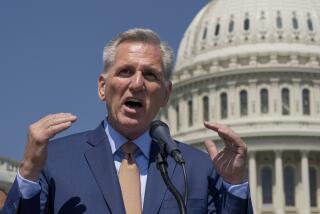U.S. Interest Payments Soar
- Share via
WASHINGTON — The fastest growing category of major federal outlays during the Reagan presidency is net interest payments--driven by record federal deficits to twice the size they were five years ago--and which threaten to continue growing at a nearly uncontrollable clip.
The federal debt has doubled since President Reagan took office, meaning that the government is paying interest on twice as much debt.
In the view of most economists, the deficits have a second effect--by compelling the government to compete for loans with private borrowers, they force interest rates up. Those higher rates in turn swell the cost to the government of continued borrowing.
It is a vicious circle: Greater deficits this year mean more debt, more borrowing, higher interest rates--and still greater deficits--next year.
In fiscal 1981, which began nearly four months before Reagan took office, the government paid a net $68.7 billion in interest payments. For fiscal 1986, which begins Oct. 1, Reagan estimates costs at $142.6 billion--a faster growth rate even than that of the defense budget.
The federal debt stood at $794 billion at the end of fiscal 1981--about 27% of the nation’s economic output that year. By the end of fiscal 1986, Reagan estimates that it will reach $1.7 trillion--40% of the annual economic output.
More to Read
Inside the business of entertainment
The Wide Shot brings you news, analysis and insights on everything from streaming wars to production — and what it all means for the future.
You may occasionally receive promotional content from the Los Angeles Times.









